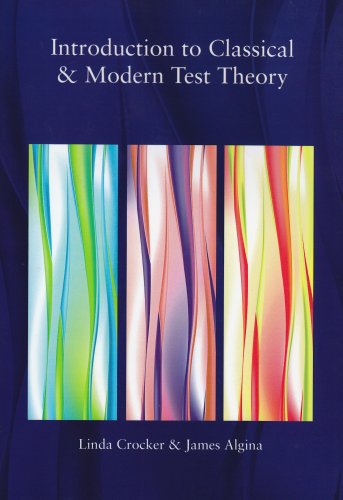Introduction to Classical and Modern Test Theory epub
Par cisneros paul le samedi, août 27 2016, 03:47 - Lien permanent
Introduction to Classical and Modern Test Theory. Linda Crocker, James Algina

Introduction.to.Classical.and.Modern.Test.Theory.pdf
ISBN: 0495395919,9780495395911 | 527 pages | 14 Mb

Introduction to Classical and Modern Test Theory Linda Crocker, James Algina
Publisher: Wadsworth Pub Co
Introduction to Classical and Modern Test Theory - L. The new scales were analyzed using Classical Test Theory (CTT) and IRM; a reduced set of items was produced with IRM and correlated with accelerometer counts per minute and minutes of sedentary, light and moderate to vigorous activity per day after school. Fort Worth: Holt, Rinehart and Winston. Introduction to Modern Traffic Flow Theory and Control - The Long Road to Three-Phase Traffic Theory 2009 | pages: 265 | ISBN: 3642026044 | PDF | 8,1 mb Download links: (Become Premium fo. Two independent distributions of possible observed scores, the correlation between error scores from the two testings is zero. Intelligent Buildings and Building Automation - S. Introduction to classical and modern test theory. Serial Box 08-2010 Free Download from rapidshare, 4shared, mediafire, direct, torrent. Crocker L, Algina R: Introduction to classical and modern test theory. Introduction to Classical and Modern Test Theory. Five Perspectives on the Validity Argument. Belmont, CA: Wadsworth/Thomson Learning. Introduction to Classical and Modern Test Theory Introduction to Classical and Modern Test Theory By Linda Crocker, James Algina 2006 | 527 Pages | ISBN:. The classical testing theory model of scale construction has a long history, and there are many textbooks available on the subject. Reference: Crocker and Algina (1986), "Introduction to Classical & Modern Test Theory," CBS College Publishing. Distance Learning Education Courses - Introduction to Classical and Modern Test Theory. Linear Algebra - An Introductory Approach - C. Theory of generalizability: A liberalization of reliability theory. New York: Rinehart & Winston; 1986. For five days and provided at least 3 full days of complete data.